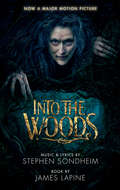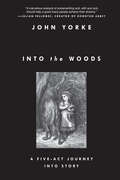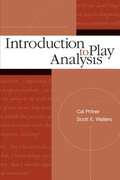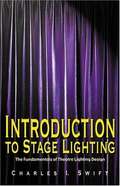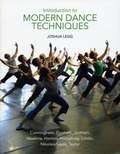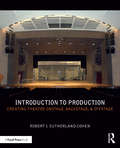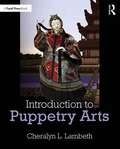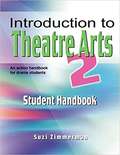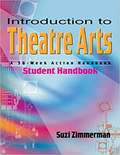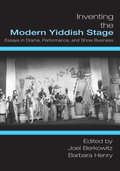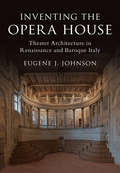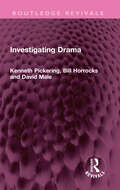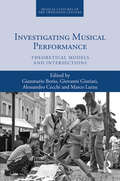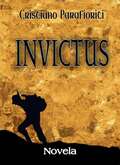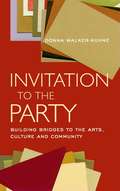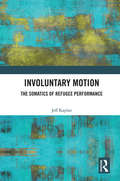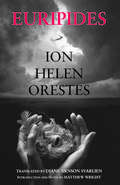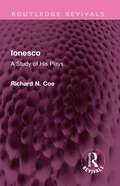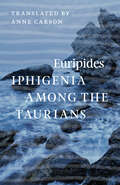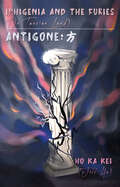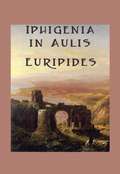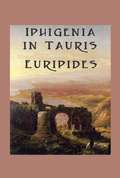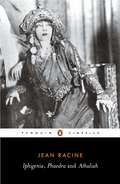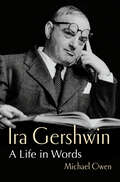- Table View
- List View
Into the Woods (movie tie-in edition)
by Stephen Sondheim James Lapine"It is that joyous rarity, a work of sophisticated artistic ambition and deep political purpose that affords nonstop pleasure."-TimeInto the Woods brings well-known fairytale characters to musical life, interwoven with the story of a baker and his wife, whose longing for a child is thwarted by a mischievous witch. Stephen Sondheim's songs, seamlessly melded to James Lapine's text, are perfect expressions of the complications of living in modern society and the difficult choices we encounter on the paths of our lives. Into the Woods premiered on Broadway in 1987, winning three Tony Awards. It has been a beloved favorite on stages throughout the United States and around the world for almost thirty years.On December 25, 2014, Into the Woods was released as a major motion picture, produced by Walt Disney Pictures. The film, directed by Rob Marshall, stars Meryl Streep, Johnny Depp, Emily Blunt, Anna Kendrick, James Corden, and Chris Pine. This book includes an eight-page insert with color photographs from the film.Stephen Sondheim wrote the lyrics for West Side Story and Gypsy, and the complete scores (music and lyrics) for A Funny Thing Happened on the Way to the Forum, Into the Woods, Company, A Little Night Music, Follies, Sunday in the Park with George, Assassins, Passion, Pacific Overtures, and Sweeney Todd, among others. He has won seven Tony Awards, eight Grammy Awards, an Academy Award, and the Pulitzer Prize for Drama, and many other honors.James Lapine wrote the book for and directed the musicals Into the Woods, Passion, and Sunday in the Park with George (all with scores by Stephen Sondheim) and Falsettos, A New Brain, Muscles, and Little Miss Sunshine (all with scores by William Finn). He has written and directed numerous plays, and has received three Tony Awards, five Drama Desk awards, and the Pulitzer Prize.
Into the Woods: A Five-Act Journey Into Story
by John YorkeAn analysis of the fundamental narrative structure, why it works, the meanings of stories, and why we tell them in the first place.The idea of Into the Woods is not to supplant works by Aristotle, Lajos Egri, Robert McKee, David Mamet, or any other writers of guides for screenwriters and playwrights, but to pick up on their cues and take the reader on a historical, philosophical, scientific, and psychological journey to the heart of all storytelling. In this exciting and wholly original book, John Yorke not only shows that there is truly a unifying shape to narrative—one that echoes the great fairytale journey into the woods, and one, like any great art, that comes from deep within—he explains why, too. With examples ranging from The Godfather to True Detective, Mad Men to Macbeth, and fairy tales to Forbrydelsen (The Killing), Yorke utilizes Shakespearean five-act structure as a key to analyzing all storytelling in all narrative forms, from film and television to theatre and novel-writing—a big step from the usual three-act approach. Into the Woods: A Five-Act Journey into Story is destined to sit alongside David Mamet’s Three Uses of the Knife, Robert McKee’s Story, Syd Field’s Screenplay, and Lajos Egri’s The Art of Dramatic Writing as one of the most original, useful, and inspiring books ever on dramatic writing.Praise for Into the Woods“Love storytelling? You need this inspiring book. John Yorke dissects the structure of stories with a joyous enthusiasm allied to precise, encyclopedic knowledge. Guaranteed to send you back to your writing desk with newfound excitement and drive.” —Chris Chibnall, creator/writer, Broadchurch and Gracepoint“Outrageously good and by far and away the best book of its kind I’ve ever read. I recognized so much truth in it. But more than that, I learned a great deal. Time and again, Yorke articulates things I’ve always felt but have never been able to describe. . . . This is a love story to story—erudite, witty and full of practical magic. I struggle to think of the writer who wouldn’t benefit from reading it—even if they don’t notice because they’re too busy enjoying every page.” —Neil Cross, creator/writer, Luther and Crossbones“Part ‘how-to’ manual, part ‘why-to’ celebration, Into the Woods is a wide-reaching and infectiously passionate exploration of storytelling in all its guises . . . exciting and thought-provoking.” —Emma Frost, screenwriter, The White Queen and Shameless
Introduction To Play Analysis
by Cal Pritner Scott WaltersFusing a variety of influences (Aristotle, Stanislavsky, Kenneth Burke, and structuralism), this new text takes students through progressively complex levels of play reading in which they: respond to a first reading; gather information from the play (including given circumstances); interpret the characters and relate them to the conflict; and synthesize perceptions that have been revealed through analysis. Its central principle is that conflict is the essence of drama: the book lays out a systematic process for analyzing plays, relating each element to the conflict explored in each play.
Introduction To Stage Lighting: The Fundamentals Of Theatre Lighting Design
by Charles I. SwiftAn indispensable reference for drama teachers, directors, architects and design professionals. Twelve chapters in three sections: Part 1 -- Tools and Terminology: All of the basics -- the evolution of sources and controls. Part 2 -- Manipulating the Light: Developing the Lighting Key -- source levels and controls. Part 3 -- The Collaborative Process: An anecdotal approach to communicating intent using modern technology.
Introduction to Modern Dance Techniques
by Joshua LeggBringing together all of the major modern dance techniques from the last 80 years, this engaging account is the first of its kind. The informative discussion starts by mapping the historical development of modern dance: in the late 19th century, a new dance emerged--not yet known as modern dance--that rejected social strictures and ballet as well. With insight into the personalities and purposes of modern dance's vanguard--including Martha Graham, Lester Horton, José Limón, and Merce Cunningham--this compilation provides a comparative approach that will enable students to discern which technique best suits them and dispel the idea that there is a single, universal modern dance technique. There are also ideas for experimentation so that students can begin developing an aesthetic sense for not only what is pleasing to their artistic eye, but also for what technical ideas are exciting while their own body is in motion. Sample lessons are included for teachers to incorporate the text into courses.
Introduction to Production: Creating Theatre Onstage, Backstage, & Offstage
by Robert I. Sutherland-CohenIntroduction to Production: Creating Theatre Onstage, Backstage, & Offstage defines the collaborative art of making theatre and the various job positions that go into realizing a production. Beginning with an overview of the art and industry of theatre, the book shows how theatre has evolved through history. The book then breaks down the nuts and bolts of the industry by looking at each professional role within it: from the topmost position of the producer down to the gopher, or production assistant. Each of these positions are defined along with their respective duties, rules, and resources that figure in obtaining these jobs. Each chapter offers exercises, links to videos and websites, review quizzes, and suggested readings to learn more about the creation and production of theatre.
Introduction to Puppetry Arts
by Cheralyn LambethIntroduction to Puppetry Arts shares the history, cultures, and traditions surrounding the ancient performance art of puppetry, along with an overview of puppet construction and performance techniques used around the world. From its earliest beginnings in the ancient Middle East and Asia, through its representations in Medieval/Renaissance Europe, up until its modern-day appearances in theatre, television, and film, this book offers a thorough overview of how this fascinating art form originated and evolved. It also includes easy-to-follow instructions on how to create puppets for performance and display and an in-depth resource list and bibliography for further research and information. Written for students in puppetry arts and stagecraft courses, Introduction to Puppetry Arts offers a comprehensive look at this enduring craft and provides a starting point for creating a wide range of puppets, from marionettes and hand puppets to mascots and character costumes.
Introduction to Theatre Arts 2: An Action Handbook for Drama Students
by Suzi ZimmermanThose who have already discovered the ease of teaching Theatre Arts with Suzi Zimmerman's first textbook will be thrilled to learn she has come out with this sequel! <p><p> This action handbook takes all the outstanding components you loved in the first book and applies it to seven new sections: 1. Theatre for Life s Lessons, 2. Movement Theatre for the Eyes, 3. Voice Theatre for the Ears, 4. Skill-Building Activities Theatre Projects, Mini-Units and Self-Guided Lessons, 5. Understanding and Writing Scripts, 6. Theatre Behind the Scenes, and 7. Production 101. Theory combined with hands-on is the style of every chapter. This series has been classroom-tested to fit the budgetary considerations of all schools.
Introduction to Theatre Arts: A 36-Week Action Handbook
by Suzi ZimmermanAt last! A student-friendly, teacher-friendly workbook with study units for a full year of classroom drama activities. <p><p> The entire spectrum of theatre is covered in ten sections: 1. Getting Started, 2. Evaluation, 3. Scene Work, 4. Acting, 5. Characterization, 6. Publicity and Other Production Business, 7. Play Production, 8. Theatre History, 9. Games and Improvisation, 10. Planning for the Future. All units are complete with detailed instructions, examples, working forms, and photo illustrations. Students will learn all the basics of theatre history, play production, performing, and finding a career in theatre. This instructional program is classroom-tested and designed to fit the budgetary considerations of schools.
Inventing the Modern Yiddish Stage: Essays in Drama, Performance, and Show Business
by Barbara Henry Joel BerkowitzCollects leading scholars' insight on the plays, production, music, audiences, and political and aesthetic concerns of modern Yiddish theater.
Inventing the Opera House: Theater Architecture In Renaissance And Baroque Italy
by Eugene J. JohnsonIn this book, Eugene J. Johnson traces the invention of the opera house, a building type of world wide importance. <P><P>Italy laid the foundation theater buildings in the West, in architectural spaces invented for the commedia dell'arte in the sixteenth century, and theaters built to present the new art form of opera in the seventeenth. Rulers lavished enormous funds on these structures. Often they were among the most expensive artistic undertakings of a given prince. They were part of an upsurge of theatrical invention in the performing arts. At the same time, the productions that took place within the opera house could threaten the social order, to the point where rulers would raze them. Johnson reconstructs the history of the opera house by bringing together evidence from a variety of disciplines, including music, art, theatre, and politics. Writing in an engaging manner, he sets the history of the opera house within its broader early modern social context.<P> This is the only book, since the 1930s, to cover this subject, and the only English language one to ever be produced.<P> Sets the subject into a broad context of the arts, politics, and social history of the period.<P> The book aims to reach both specialists and the general reader, making it appealing to those who know the field well and those who do not care to plow through scholarly jargon.
Investigating Drama (Routledge Revivals)
by Kenneth Pickering David Male Bill HorrocksFirst published in 1974, Investigating Drama offers a holistic understanding of drama. An understanding of drama requires far more thana study, however thorough, of plays and playwright, stagecraft and techniques, for drama must always be seen in the context of the theatre at work. A descriptive coverage of the basic elements of drama is accordingly only half the purpose of this book, and the authors hope that their plea in the title for an ‘investigation’ will be taken literally. To allow maximum flexibility the book is divided into independent ‘units’, which can be followed through as a complete drama course, or taken individually by those wishing to concentrate on selective areas. All aspects of theatre are covered and there is ample opportunity for practical work in improvisation. This book will be of interest to students of literature and drama.
Investigating Musical Performance: Theoretical Models and Intersections (Musical Cultures of the Twentieth Century)
by Gianmario Borio Giovanni Giuriati Alessandro Cecchi Marco LutzuInvestigating Musical Performance considers the wide range of perspectives on musical performance made tangible by the cross-disciplinary studies of the last decades and encourages a comparison and revision of theoretical and analytical paradigms. The chapters present different approaches to this multi-layered phenomenon, including the results of significant research projects. The complex nature of musical performance is revealed within each section which either suggests aspects of dialogue and contiguity or discusses divergences between theoretical models and perspectives. Part I elaborates on the history, current trends and crucial aspects of the study of musical performance; Part II is devoted to the development of theoretical models, highlighting sharply distinguished positions; Part III explores the relationship between sign and sound in score-based performances; finally, the focus of Part IV centres on gesture considered within different traditions of musicmaking. Three extra chapters by the editors complement Parts I and III and can be accessed via the online Routledge Music Research Portal. The volume shows actual and possible connections between topics, problems, analytical methods and theories, thereby reflecting the wealth of stimuli offered by research on the musical cultures of our times.
Invictus
by Cristiano ParafioritiLa épica historia de Ture Di Nardo, conocido como "Pileri", un joven campesino siciliano arrancado de su familia y su mujer por la llamada a las armas durante la Segunda Guerra Mundial. Alistado en los Alpini y formando parte de la División Julia, siguió el amargo destino del ARMIR en lo que sería la mayor derrota militar italiana del siglo XX. Como un nuevo Ulisse, el joven Ture Pileri tendrá que enfrentarse a terribles pruebas en el largo viaje de vuelta a casa. Con esta apasionante novela histórica, Cristiano Parafioriti saca a la luz una historia real que ha permanecido en el corazón de su protagonista durante setenta años. La fuerza de un hombre, impulsado por el amor, capaz de resistir y reaccionar ante la derrota de todo un ejército.
Invitation to the Party
by Donna Walker-Kuhne George C. WolfeAcknowledged as the nation's foremost expert on audience development involving America's growing multicultural population by the Arts and Business Council, Donna Walker-Kuhne has now written the first book describing her strategies and methods to engage diverse communities as participants for arts and culture. By offering strategic collaborations and efforts to develop and sustain nontraditional audiences, this book will directly impact the stability and future of America's cultural and artistic landscape. Donna Walker-Kuhne has spent the last 20 years developing and refining these principles with such success as both the Broadway and national touring productions of Bring in 'Da Noise, Bring in 'Da Funk, as well as transforming the audiences at one of the U.S.'s most important and visible arts institutions, New York's Public Theater. This book is a practical and inspirational guide on ways to invite, engage and partner with culturally diverse communities, and how to enfranchise those communities into the fabric of arts and culture in the United States.Donna Walker-Kuhne is the president of Walker International Communications Group. From 1993 to 2002, she served as the marketing director for the Public Theater in New York, where she originated a range of audience-development activities for children, students and adults throughout New York City. Ms. Walker-Kuhne is an Adjunct Professor in marketing the arts at Fordham University, Brooklyn College and New York University. She was formerly marketing director for Dance Theatre of Harlem. Ms. Walker-Kuhne has given numerous workshops and presentations for arts groups throughout the U.S., including the Arts and Business Council, League of American Theaters and Producers, the Department of Cultural Affairs, and the National Endowment for Arts to name a few. She has been nominated for the Ford Foundation's 2001 Leadership for a Changing World Fellowship.
Involuntary Motion: The Somatics of Refugee Performance
by Jeff KaplanInvoluntary Motion contributes to the study of refugee flight by using movement as a lens to explore problems in refugee performance and understand the experience of bodies in motion. Drawing from Somatics, Movement Analysis, and dance praxis, the chapters explore forces that set bodies in motion; the spaces in which forced movement occurs; the movement of refugee identity arcs; the monstrosity of refugee performance; and the relationship between writing and body culture. How does forced movement impact identity? What are the philosophical implications of robbing agency over motion? What performances does involuntary motion necessitate? These questions are important as the world confronts the threat of a return of the horrors of the Twentieth Century. Bringing together debates in Migration Studies and Movement Studies, the book argues that refugees are akin to dancers performing on disappearing stages, not of their choosing. It will be of great interest to students and scholars of performance, dance and politics.
Ion, Helen, Orestes
by Euripides Matthew Wright Diane Arnson SvarlienAn acclaimed translator of Euripidean tragedy in its earlier and more familiar modes, Diane Arnson Svarlien now turns to three plays that showcase the special qualities of Euripides’ late dramatic art. Like her earlier volumes, Ion, Helen, Orestes offers modern, accurate, accessible, and stageworthy versions that preserve the metrical and musical form of the originals. Matthew Wright’s Introduction and notes offer illuminating guidance to first-time readers of Euripides, while pointing up the appeal of this distinctive grouping of plays.
Ionesco: A Study of His Plays (Routledge Revivals)
by Richard CoeFirst published in 1971, Ionesco is a study of the plays written by the absurdist playwright Eugene Ionesco. Eugene Ionesco’s play La Cantatrice Chauve, first presented in 1950, established him as one of the most provocative leaders of post-war ‘Theatre of the Absurd’. By 1970, his work had been performed by leading actors and companies all over the world. The author attempts to understand this enigmatic playwright and his plays, while trying to explore the reasons behind his quick popularity. This book will be of interest to students of literature, drama, philosophy, and history.
Iphigenia Among the Taurians
by EuripidesThe brilliant and gripping classical drama of mistaken identities, divine intervention, a long-suffering family, and the rescue of a long-lost sister.I am Iphigenia, daughter of the daughter of Tyndareus.My father killed me.Few contemporary poets elicit such powerful responses from readers and critics as Anne Carson. The New York Times Book Review calls her work “personal, necessary, and important,” while Publishers Weekly says she is “nothing less than brilliant.” Her poetry—enigmatic yet approachable, deeply personal yet universal in scope, wildly mutable yet always recognizable as her distinct voice—invests contemporary concerns with the epic resonance and power of the Greek classics that she has studied, taught, and translated for decades.Iphigenia Among the Taurians is the latest in Carson’s series of translations of the plays of Euripides. Originally published as part of the third edition of Chicago’s Complete Greek Tragedies, it is published here as a stand-alone volume for the first time. In Carson’s stunning translation, Euripides’s play—full of mistaken identities, dangerous misunderstandings, and unexpected interventions by gods and men—is as fierce and fresh as any contemporary drama. Carson has accomplished one of the rarest feats of translation: maintaining fidelity to a writer’s words even as she inflects them with her own unique poetic voice.Destined to become the standard translation of the play, Iphigenia Among the Taurians is a remarkable accomplishment, and an unforgettable work of poetic drama.
Iphigenia and the Furies (On Taurian Land) & Antigone: 方
by Ho Ka Kei (Jeff Ho)From the author of trace comes two adaptations that transport mythological stories from Ancient Greece to modern-day civilizations. Led by people of colour, these darkly comedic plays depict recognizable plights for justice. Iphigenia and the Furies (On Taurian Land) highlights the repetition of hate and colonialism that occur in ancient myths through a mischievous lens. Since Iphigenia was rescued from the sacrificial altar, she has served as a high priestess to the goddess Artemis on Tauros, where she in turn is to sacrifice any foreigners who try to enter. When she discovers that an exiled prisoner is her brother, they together plot their escape, but are soon confronted by a force beyond their control. Antigone: 方is set against the backdrop of the Hong Kong Umbrella Movement and Tiananmen Square Massacre protests. When citizens challenge a state’s traditional doctrine, the ruling family is divided between their own interests and those of its citizens. After brothers Neikes and Teo kill each other in the protests, their sister Antigone defies her father’s orders to retrieve Neikes’s body, causing the government—and what’s left of their family—to reach a reckoning.
Iphigenia in Aulis
by EuripidesIn this new translation of Euripides' celebrated Greek tragedy, W.S. Merwin and George E. Dimock, Jr. offer a compelling look at the devastating consequence of 'man's inhumanity to man.' A stern critique of Greek culture, Iphigeneia at Aulis condemns the Trojan War by depicting the power of political ambition and the ensuing repercussions of thoughtlessly falling to the will of constituency. The translation impressively re-creates the broad array of moral and emotional tones conveyed by Euripides, with a comprehensive introduction, notes on the text, and a glossary of mythical and geographical terms.
Iphigenia in Tauris
by Euripides"The Iphigenia in Tauris is not in the modern sense a tragedy; it is a romantic play, beginning in a tragic atmosphere and moving through perils and escapes to a happy end. To the archaeologist the cause of this lies in the ritual on which the play is based. All Greek tragedies that we know have as their nucleus something which the Greeks called an Aition-a cause or origin. They all explain some ritual or observance or commemorate some great event." So begins the preface to "Iphigenia in Tauris" by Euripides as translated and prefaced by Gilbert Murray.
Iphigenia, Phaedra, Athaliah
by Jean RacineStrongly influenced by Classical drama, Jean Racine (1639-99) broke away from the grandiose theatricality of baroque drama to create works of intense psychological realism, with characters manipulated by cruel and vengeful gods. Iphigenia depicts a princess's absolute submission to her father's will, despite his determination to sacrifice her to gain divine favour before going to war. Described by Voltaire as 'the masterpiece of the human mind', Phaedra shows a woman's struggle to overcome her overwhelming passion for her stepson - an obsession that brings destruction to a noble family. And Athaliah portrays a ruthless pagan queen, who defies Jehovah in her desperate attempt to keep the throne of Jerusalem from its legitimate heir.
Ira Gershwin: A Life in Words
by Michael OwenThe man behind some of the most memorable lyrics in the Great American Songbook steps from behind his brother’s shadow. The first lyricist to win the Pulitzer Prize, Ira Gershwin (1896–1983) has been hailed as one of the masters of the Great American Songbook, a period which covers songs written largely for Broadway and Hollywood from the 1920s to the 1950s. Now, in the first full-length biography devoted to his life, Michael Owen brings Ira out at last from the long shadow cast by his younger and more famous brother George. Drawing on extensive archival sources and often using Ira’s own words, Owen has crafted a rich portrait of the modest man who penned the words to many of America’s best-loved songs, like “Fascinating Rhythm,” “Embraceable You,” and “They Can’t Take That Away from Me.” These fruits of Ira’s lyric genius sprang from the simplest of seeds: a hand-drawn weekly created for a cousin, an amateur newspaper co-written with friend and future lyricist Yip Harburg, columns in the school papers at Townsend Harris High School and, later, City College of New York. The details of his early literary efforts demonstrate both his developing ambition and the early signs of his talent. But while the road to becoming a successful lyricist was neither short nor smooth, it did lead Ira to the greatest creative partnership of his life. George and Ira Gershwin collaborated on a string of hit Broadway shows in the 1920s and 1930s that resulted in popular and financial success and spawned a long string of songs that have become classics. Owen offers fascinating glimpses of their creative process, drawing on Ira’s diaries and other contemporary sources, as well as the close relationship between the two brothers. Hollywood soon beckons and the brothers head west to California to work in the movie business. Greater fame and fortune seem right around the corner. George Gershwin died in a Los Angeles hospital in July 1937. He was only 38 years old. His death marked a stark dividing line in Ira’s life, and from that point on much of his time and energy was devoted to the management of his brother’s estate and the care of his legacy. Accustomed to living in his brother’s shadow, it now threatened to overwhelm him. He worked to balance all the administrative tasks with a new series of collaborations with composers like Kurt Weill, Jerome Kern, Harry Warren, and Harold Arlen. Ira’s last Broadway work was in 1946, and several films and a book project—a collection of his lyrics with the stories behind them—occupied his later years along with the ongoing management of George’s affairs. Ira Gershwin’s work with George left an enduring mark on American culture, as recognized by the Library of Congress in 2007 when it established the Gershwin Prize for Popular Song, which has been awarded to artists like Paul Simon, Carole King, Tony Bennett, Paul McCartney, and Elton John. In Ira Gershwin: A Life in Words, Michael Owen brings the publicity shy lyricist into the spotlight he deserves.
